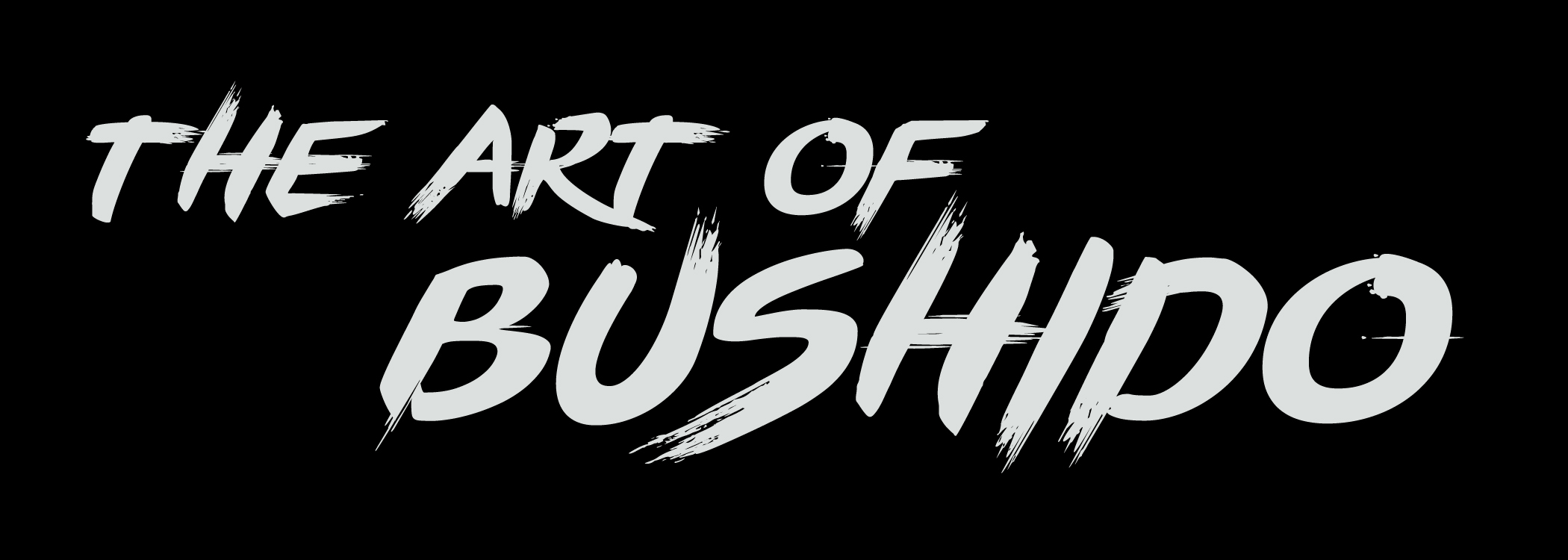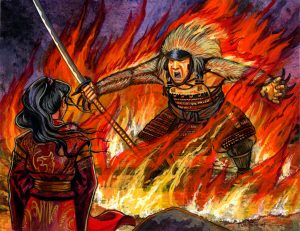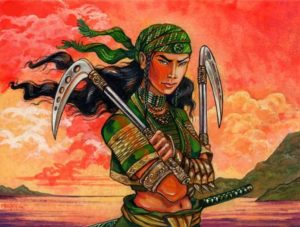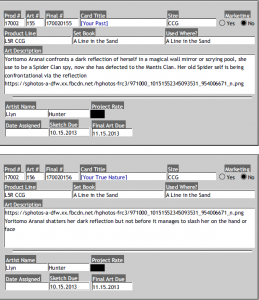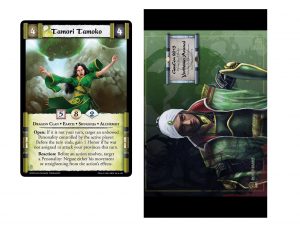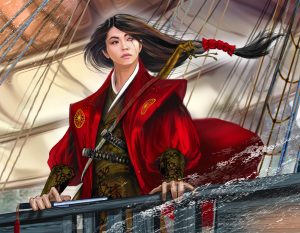What work did you do professionally as an artist before working for AEG?
I was a production artist for printing, art director and graphic designer for an ad agency, graphic artist for the Los Angeles Zoo, art director for an educational publishing firm, children’s illustrator, and finally a storyboard artist for television animation. It was while I was doing that that I bombarded AEG with samples and John Zinser finally gave me a chance on 7th Sea. Then It wasn’t until he bought L5R back from WotC that I first got to work on it.
What initially brought you to AEG and their games? Was this the first time you worked in the gaming industry?
I actually don’t play the games myself – I would become a chronic player – and art consumes enough time as it is. But I loved the artwork on the cards and all of the stories behind them. I”m a fan of the Sengoku period of Japan and wanted create characters for that kind of period. At the time I was sending samples around to all of the gaming companies that used fantasy art hoping to produce it. I actually did two pieces for L5R while it was owned by WotC but they never used them, when AEG bought back the game I offered the pieces to them, and started getting regular assignments after that. I’ve done a few pieces for some of the other gaming companies but most of my work has been for AEG.
How did your previous work experience help you when working for AEG?
Not much. That’s why I wanted to work for AEG. Most of what I did previously was design, and production work. I spent 3 years trying to make it as a full time freelance illustrator, but tax structure back then was really hard on the self-employed, so I went into animation where I could earn a salary (and a pension). I’m a painter and love fantasy and history, AEG was producing games with the images I really wanted to create. When we finally connected, they gave me an outlet for my creativity, along with a bit of extra cash, while the animation industry supported the mortgage.
Were those two pieces you made for the game while under WotC ever used by AEG?
Yes, Bayushi Ambushers and Power, I still have both and cherish them.
You say AEG was producing games with images you wanted to create. Do you mean that the setting of L5R was particularly appealing to you? If so you wouldn’t be the first artist I’ve heard say they liked working on the game due to its particular setting.
Oh yes, I am an extreme Japanophile and love the Sengoku Period. With L5R I was able to create armor and costumes that were similar to the period without having to be totally accurate. I especially enjoyed when the Mantis Clan came into being. I wanted to give a Philippine feeling to the costumes, and I incorporated a lot of that into the artwork. Even though I didn’t play the game I knew how much the players loved it. Whenever I was given a character of a specific clan, I tried as much as possible to get a strong sense of that clan into the character. I always hoped when a player got one of my cards that they knew I was thinking about them.
So you gave your Mantis a Philippine inspired appearance. Looking at the other Mantis from that time they don’t share this same look. Was the style guide pretty loose on what you could do with your assignments?
The Mantis clan wasn’t fully described in the original style guide, they came later and did not have a real specific background like, for example, the Cranes. You knew from descriptions in the bible that all clan costumes were influenced by Asian countries, though technically Japanese. For example the Lions and Crane were probably the most Japanese looking in costume. The Dragons and Phoenix were more “Chinese”, the Unicorns – “Mongols”, the Scorpions – “Tia”. The Mantis were described as “seafaring pirates.” I have some great books on historical native costume, and I thought that that of the Philippines fit the bill fantastically. So whenever I was given a Mantis to do, I stuck to that, and the art art director had no problem with it. There were a lot of liberties taken with costumes by other artists, and I think that was great idea. It kept the world an Asia in an alternate reality. I think the Mantis went all over the place, because there were so few specifics.
I see you did continue to work on the Mantis in later sets of the game. Did the style guide ever get more refined for them or was it left pretty open? Also playing off that, were there other parts of the style guide left open that you took more artistic liberty with?
They did do one revision of the style guide. They put several images of what they considered the best examples of the clans from past art, but did little to expand on written descriptions of the clans. As the “Clan Guide” books came out I would also use them for reference if someone was from a specific branch of the clan. I personally tried to keep as close to prescribed conventions as possible. I felt if I were playing the game and the individual on the card was from my adopted clan, I would want it to have as many personality and symbol attributes from it as possible. That doesn’t go for all of the artists. I suspect if someone went too of the bible rails, Jim Pinto, the art director, would make a point to pull them back. the liberties I took came mostly with the character personalities.
Assuming you did see a lot of the other works for the game, were there any particular pieces that stood out to you from the game over others? Or particular artists who did?
Oh yah, and please don’t let me slight anyone by not naming them because there were so many amazing pieces and artists that worked on the game. Note as artists, we often had to go out and buy our own AEG reference – they didn’t send us any sets of cards unless maybe your art was on the cover of the box, so there is also a lot I didn’t get to see. I will mention two. April Lee always took so much care with her costumes and personalities; I’ve always loved her and work. She actually organized an illustrator’s chat room long before that was readily available, where many of the artists who worked in the gaming industry would post jobs and ideas. And my second would be Bill O’connor; that man can paint. He always created new and interesting compositions that were unusual and eye catching. He didn’t always seem to care for making costumes look true to a particular asian group (note that Japanese style lamellar armor is time consuming to depict in detail), but what he came up with was full of story and character.
So you didn’t get too much in the way of visual reference from AEG? How much information did you get regarding the story when receiving a commission?
For the answer to this Llyn provided me examples of what she would get when being commissioned
So with the given story information limited to just a few sentences, did you ever go out and try and get further information on the character yourself? By either reading the produced fiction or speaking with any of the fans.
For most of the game, that was very difficult. You’ve got to remember, the internet was still growing at that point. it was before the age of that kind information readily available. Also, you had to pay for your own extra stuff (i.e. clan books) and then, even if I did go out and buy one, my local gaming store didn’t always carry what I needed, and I don’t recall when AEG offered sale of their items on their own website. We were usually given a month from start to finish to do an assignment – so ordering anything extra would take time for delivery. Amazing how everyone takes the almost instantaneous information and delivery for granted now. Anything before say 2005 wasn’t easy to find – computers were slow and access was limited. As to talking to fans, again, low access. It would have been nice to talk to them, but between a full time job in animation while working freelance and trying to have a life outside of work, I’m afraid it would have been a tough fit.
While characters and some actions seemed liked they’d be easier to bring to life, how was it for the handful of items you had to make? Did bringing an inanimate object to life pose any unique challenges?
Indeed. When you just get a title, it doesn’t give you much to go on to come up with ideas. I figured the both the “furniture” on the swords and the background would help making the swords stand out as distinct characters themselves on the gaming table and to the players who used them. I have a large selection of books on Japanese art and architecture, not to mention arms and armor, and all were used as touchstones and inspiration.
Were you a fan of that source material prior to working on the game or was it picked up after you started illustrating for AEG?
I’m a major Japanophile, always have been. I started collecting anything connected with Sengoku / Edo period stuff from the first time I could get a hold of it, which was kind of difficult for a kid growing up in Mesa, Arizona. It’s amazing how much information I have access to now compared to when I first started working on L5R. I was lucky enough to live in Los Angeles then with lots of used book stores – and that’s where I found my first stuff. Oh and don’t forget Kinokuniya! They are one of the biggest bookstores in Japan, and have a branch in LA. I purchased a lot of reference there. The internet really didn’t get rolling with reference until around 2005 or so. Then I had access so much more information. Before then it was though to get Japanese samurai films on DVD and everything was so expensive. Now if I want reference I can screen grab images off of YouTube. Note I am a also black belt in Shotokan Karate Do and Kodokan Judo and speak read and write elementary level Japanese. To work on artwork for a fantasy Japan / Asia, was just too much fun for someone like me.
Looking back are there any pieces you’d have done differently?
Oh yeah, Several. The problem with being an artist is that you are your own worst critic. The moment you get done with a piece you want to redo the entire thing. And as a professional artist, I’ve always got too much on my plate, and not enough time to do it. There was one the called “The Blue Tanuki Bar” That I really loved the concept and didn’t have the time to really work out the details. It still turned out okay, but I would have liked to have worked on the lighting and costumes a bit more.
On the flip side of that, were there any you feel you absolutely nailed and couldn’t have done better?
That’s tough one. I’m an artist – we are NEVER satisfied with anything we do. That being said, I have a couple I will never part with because I fell in love with them. I’m afraid I have a penchant for Japanese men, another reason why I had so much fun with L5R. So, when I get to do the boys, I always have fun putting my “all” into them. My two favorites are Asahina Kitaro and Doji Shunya. Those two came close to everything I wanted out of a an L5R piece. With Kitaro I got to do a black haired crane (the family was one of those with black hair – unusual for the cranes) and threw extra crane symbols into the votive pots and his kimono. I really like the look and the expression I gave him and all the color and lighting turned out just right. I wanted to give him a powerful elegance, and just really like him. With Shunya I wanted to create the ultimate courtier “pretty boy”, and him I nailed. I wanted to do the man the girls would all swoon for (and a few of the boys too). I felt honored to be able to do the card for Kanenka when he became a Phonenix and I thought turned out pretty well. I have always enjoyed playing with the Mantis clan and think Yoritomo kumiko, Youritomo ichido and Moshi Yosinnaka are some of my favorites. Of my digital work I think Ruby Ascendance is my favorite. I like it when I get to take a character through a story arch, and she really rose rose through the game.
How would you say your work for L5R helped with your other artistic work, including any of your storyboarding?
Working as artist is like being a athlete: Even when you are not participating in your main event, participating in others improves all of your skills. That being said. I used a lot of my staging chops in L5R and L5R improved my detail and painting skills. I loved the focus I would have to create a single image. When storyboarding, you are creating the blueprint for a animation and draw quickly getting the visual information across as fast as possible with hundreds of drawings. With illustration, you are trying to convey an entire story or mood with a single shot. I appreciate the challenges of both and have been lucky enough to participate in each area of professional art. Bother are at the center of everything I love to do most; telling stories with pictures.
Llyn provided the following statement regarding her time with the game after this interview was posted
L5R was one of the most amazing adventures of my life; it was a pleasure and blind luck to be a part of. I would really like to thank all the gamers and the folks at AEG for letting me be a part of it, and I love knowing that I got to be a small part of all of your lives. We get only so many chances to touch each other’s imaginations, and this game created worlds where we all got to be warriors, lords, and monsters, without ever killing anyone while destroying thousands. I thank you for touching my world, and I hope I added to the enjoyment of yours.
